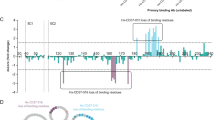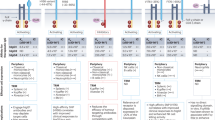Abstract
The therapeutic efficacy of humanized or chimeric second-generation antitumor antibodies is clearly established, but often limited. In recent years, defined modifications of the glycosylation pattern or the amino-acid sequence of the human immunoglobulin G1 Fc part have resulted in the development of third-generation antibodies with improved capability to recruit Fc receptor-bearing effector cells. The first antibodies of this kind, currently evaluated in early clinical trials, are directed against lymphoma-associated antigens. Fc-engineered antibodies targeting myeloid leukemia are not yet available. We here report on the generation and preclinical characterization of an Fc-optimized antibody directed to the FMS-related tyrosine kinase 3 (FLT3), an antigen expressed on the leukemic blasts of all investigated patients with acute myeloid leukemia (AML). This antibody, termed 4G8SDIEM, mediated markedly enhanced cellular cytotoxicity against FLT3-expressing cell lines as well as blasts of AML patients. FLT3 expression levels on AML cells varied between 300 and 4600 molecules/cell and, in most cases, were substantially higher than those detected on normal hematopoietic precursor cells and dendritic cells (approximately 300 molecules/cell). Antibody-mediated cytotoxicity against these normal cells was not detectable. 4G8SDIEM has been produced in pharmaceutical quality in a university-owned production unit and is currently used for the treatment of leukemia patients.
This is a preview of subscription content, access via your institution
Access options
Subscribe to this journal
Receive 12 print issues and online access
$259.00 per year
only $21.58 per issue
Buy this article
- Purchase on Springer Link
- Instant access to full article PDF
Prices may be subject to local taxes which are calculated during checkout






Similar content being viewed by others
References
Oflazoglu E, Audoly LP . Evolution of anti-CD20 monoclonal antibody therapeutics in oncology. MAbs 2010; 2: 14–19.
Beck A, Wurch T, Bailly C, Corvaia N . Strategies and challenges for the next generation of therapeutic antibodies. Nat Rev Immunol 2010; 10: 345–352.
Shinkawa T, Nakamura K, Yamane N, Shoji-Hosaka E, Kanda Y, Sakurada M et al. The absence of fucose but not the presence of galactose or bisecting N-acetylglucosamine of human IgG1 complex-type oligosaccharides shows the critical role of enhancing antibody-dependent cellular cytotoxicity. J Biol Chem 2003; 278: 3466–3473.
Lazar GA, Dang W, Karki S, Vafa O, Peng JS, Hyun L et al. Engineered antibody Fc variants with enhanced effector function. Proc Natl Acad Sci USA 2006; 103: 4005–4010.
Robak T . GA-101, a third-generation, humanized and glyco-engineered anti-CD20 mAb for the treatment of B-cell lymphoid malignancies. Curr Opin Investig Drugs 2009; 10: 588–596.
Awan FT, Lapalombella R, Trotta R, Butchar JP, Yu B, Benson Jr DM et al. CD19 targeting of chronic lymphocytic leukemia with a novel Fc-domain-engineered monoclonal antibody. Blood 2010; 115: 1204–1213.
Horton HM, Bernett MJ, Pong E, Peipp M, Karki S, Chu SY et al. Potent in vitro and in vivo activity of an Fc-engineered anti-CD19 monoclonal antibody against lymphoma and leukemia. Cancer Res 2008; 68: 8049–8057.
Foyil KV, Bartlett NL . Anti-CD30 antibodies for Hodgkin lymphoma. Curr Hematol Malig Rep 2010; 5: 140–147.
Feldman EJ, Brandwein J, Stone R, Kalaycio M, Moore J, O’Connor J et al. Phase III randomized multicenter study of a humanized anti-CD33 monoclonal antibody, lintuzumab, in combination with chemotherapy, versus chemotherapy alone in patients with refractory or first-relapsed acute myeloid leukemia. J Clin Oncol 2005; 23: 4110–4116.
Roberts AW, He S, Ritchie D, Hertzberg MS, Kerridge I, Durrant ST et al. A phase I study of anti-CD123 monoclonal antibody (mAb) CSL360 targeting leukemia stem cells (LSC) in AML. J Clin Oncol (Meet Abstr) 2010; 28 (15_Suppl): e13012.
Kikushige Y, Yoshimoto G, Miyamoto T, Iino T, Mori Y, Iwasaki H et al. Human Flt3 is expressed at the hematopoietic stem cell and the granulocyte/macrophage progenitor stages to maintain cell survival. J Immunol 2008; 180: 7358–7367.
Dahl C, Hoffmann HJ, Saito H, Schiotz PO . Human mast cells express receptors for IL-3, IL-5 and GM-CSF; a partial map of receptors on human mast cells cultured in vitro. Allergy 2004; 59: 1087–1096.
Toba K, Koike T, Shibata A, Hashimoto S, Takahashi M, Masuko M et al. Novel technique for the direct flow cytofluorometric analysis of human basophils in unseparated blood and bone marrow, and the characterization of phenotype and peroxidase of human basophils. Cytometry 1999; 35: 249–259.
Lim LH, Burdick MM, Hudson SA, Mustafa FB, Konstantopoulos K, Bochner BS . Stimulation of human endothelium with IL-3 induces selective basophil accumulation in vitro. J Immunol 2006; 176: 5346–5353.
Rappold I, Ziegler BL, Kohler I, Marchetto S, Rosnet O, Birnbaum D et al. Functional and phenotypic characterization of cord blood and bone marrow subsets expressing FLT3 (CD135) receptor tyrosine kinase. Blood 1997; 90: 111–125.
Meeker TC, Miller RA, Link MP, Bindl J, Warnke R, Levy R . A unique human B lymphocyte antigen defined by a monoclonal antibody. Hybridoma 1984; 3: 305–320.
Weisberg E, Sattler M, Ray A, Griffin JD . Drug resistance in mutant FLT3-positive AML. Oncogene 2010; 29: 5120–5134.
Dong J, McPherson CM, Stambrook PJ . Flt-3 ligand: a potent dendritic cell stimulator and novel antitumor agent. Cancer Biol Ther 2002; 1: 486–489.
McKenna HJ . Role of hematopoietic growth factors/flt3 ligand in expansion and regulation of dendritic cells. Curr Opin Hematol 2001; 8: 149–154.
Waskow C, Liu K, Darrasse-Jeze G, Guermonprez P, Ginhoux F, Merad M et al. The receptor tyrosine kinase Flt3 is required for dendritic cell development in peripheral lymphoid tissues. Nat Immunol 2008; 9: 676–683.
Harada S, Kimura T, Fujiki H, Nakagawa H, Ueda Y, Itoh T et al. Flt3 ligand promotes myeloid dendritic cell differentiation of human hematopoietic progenitor cells: possible application for cancer immunotherapy. Int J Oncol 2007; 30: 1461–1468.
Kingston D, Schmid MA, Onai N, Obata-Onai A, Baumjohann D, Manz MG . The concerted action of GM-CSF and Flt3-ligand on in vivo dendritic cell homeostasis. Blood 2009; 114: 835–843.
Herrmann T, Grosse-Hovest L, Otz T, Krammer PH, Rammensee HG, Jung G . Construction of optimized bispecific antibodies for selective activation of the death receptor CD95. Cancer Res 2008; 68: 1221–1227.
Grosse-Hovest L, Hartlapp I, Marwan W, Brem G, Rammensee HG, Jung G . A recombinant bispecific single-chain antibody induces targeted, supra-agonistic CD28-stimulation and tumor cell killing. Eur J Immunol 2003; 33: 1334–1340.
Evan GI, Lewis GK, Ramsay G, Bishop JM . Isolation of monoclonal antibodies specific for human c-myc proto-oncogene product. Mol Cell Biol 1985; 5: 3610–3616.
Jung G, Freimann U, Von MZ, Reisfeld RA, Wilmanns W . Target cell-induced T cell activation with bi- and trispecific antibody fragments. Eur J Immunol 1991; 21: 2431–2435.
Sutherland DR, Anderson L, Keeney M, Nayar R, Chin-Yee I . The ISHAGE guidelines for CD34+ cell determination by flow cytometry. International Society of Hematotherapy and Graft Engineering. J Hematother 1996; 5: 213–226.
Otz T, Grosse-Hovest L, Hofmann M, Rammensee HG, Jung G . A bispecific single-chain antibody that mediates target cell-restricted, supra-agonistic CD28 stimulation and killing of lymphoma cells. Leukemia 2009; 23: 71–77.
Ullrich A, Schlessinger J . Signal transduction by receptors with tyrosine kinase activity. Cell 1990; 61: 203–212.
Sanz M, Burnett A, Lo-Coco F, Lowenberg B . FLT3 inhibition as a targeted therapy for acute myeloid leukemia. Curr Opin Oncol 2009; 21: 594–600.
Piloto O, Levis M, Huso D, Li Y, Li H, Wang MN et al. Inhibitory anti-FLT3 antibodies are capable of mediating antibody-dependent cell-mediated cytotoxicity and reducing engraftment of acute myelogenous leukemia blasts in nonobese diabetic/severe combined immunodeficient mice. Cancer Res 2005; 65: 1514–1522.
Ginaldi L, De Martinis M, Matutes E, Farahat N, Morilla R, Catovsky D . Levels of expression of CD19 and CD20 in chronic B cell leukaemias. J Clin Pathol 1998; 51: 364–369.
Beers SA, French RR, Chan HT, Lim SH, Jarrett TC, Vidal RM et al. Antigenic modulation limits the efficacy of anti-CD20 antibodies: implications for antibody selection. Blood 2010; 115: 5191–5201.
Beum PV, Kennedy AD, Williams ME, Lindorfer MA, Taylor RP . The shaving reaction: rituximab/CD20 complexes are removed from mantle cell lymphoma and chronic lymphocytic leukemia cells by THP-1 monocytes. J Immunol 2006; 176: 2600–2609.
Davis ID, Chen Q, Morris L, Quirk J, Stanley M, Tavarnesi ML et al. Blood dendritic cells generated with Flt3 ligand and CD40 ligand prime CD8+ T cells efficiently in cancer patients. J Immunother 2006; 29: 499–511.
Acknowledgements
We thank Sabrina Grimm and Sandra Drescher for expert technical assistance. This work was supported by the GO-Bio programme of the Federal Ministry for Education and Research (BMBF), Germany, and in part by a grant from the Deutsche Forschungsgemeinschaft (SFB 685, project C10).
Author information
Authors and Affiliations
Corresponding author
Ethics declarations
Competing interests
LG-H, SA, H-GR and GJ are co-owners of a recently founded company, Synimmune GmbH. The company will develop antitumor antibodies optimized by gene technology. Its foundation is a prerequisite for further funding by the GO-Bio programme of the Federal Ministry for Education and Research (BMBF), Germany.
Additional information
Supplementary Information accompanies the paper on the Leukemia website
Supplementary information
Rights and permissions
About this article
Cite this article
Hofmann, M., Große-Hovest, L., Nübling, T. et al. Generation, selection and preclinical characterization of an Fc-optimized FLT3 antibody for the treatment of myeloid leukemia. Leukemia 26, 1228–1237 (2012). https://doi.org/10.1038/leu.2011.372
Received:
Revised:
Accepted:
Published:
Issue Date:
DOI: https://doi.org/10.1038/leu.2011.372
Keywords
This article is cited by
-
Phase I study evaluating the Fc-optimized FLT3 antibody FLYSYN in AML patients with measurable residual disease
Journal of Hematology & Oncology (2023)
-
Advancing Biomarker Development Through Convergent Engagement: Summary Report of the 2nd International Danube Symposium on Biomarker Development, Molecular Imaging and Applied Diagnostics; March 14–16, 2018; Vienna, Austria
Molecular Imaging and Biology (2020)
-
CAR T-cells targeting FLT3 have potent activity against FLT3−ITD+ AML and act synergistically with the FLT3-inhibitor crenolanib
Leukemia (2018)
-
An atlas of bloodstream-accessible bone marrow proteins for site-directed therapy of acute myeloid leukemia
Leukemia (2018)
-
Tyrosine kinase inhibition increases the cell surface localization of FLT3-ITD and enhances FLT3-directed immunotherapy of acute myeloid leukemia
Leukemia (2018)



